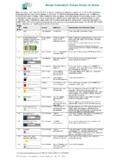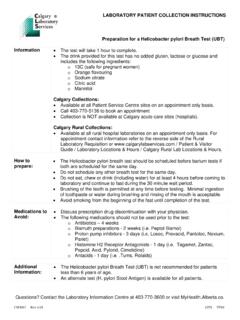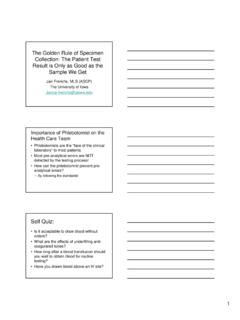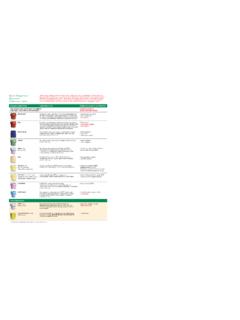Transcription of Factors Affecting Blood Test Results
1 Visit for the most current version of this document PX-SC250 Phlebotomy Related Risk Attachment 1 Factors Affecting Blood Test Results Page 1 of 3 Factors Affecting Blood Test Results Proper specimen collection and handling techniques are critical for accurate test Results . The following table summarizes errors that can occur in Blood specimen collection and handling. Blood collection or Handling Technique Potential Error Correct Procedure Not allowing alcohol to air dry after cleansing the venipuncture site The introduction of alcohol into the specimen may cause hemolysis. Allow alcohol to completely air dry on skin before drawing the sample.
2 Not following the order of draw Contamination from other additives could interfere with test Results . Plastic or glass serum tubes containing a clot activator may cause interference in coagulation testing. Always follow correct order of draw. Improper mixing, including inadequate mixing or vigorously shaking tube after collection Vigorous shaking of tubes can cause hemolysis. Inadequate mixing can cause clotting or presence of clots. Gently invert tubes the specified number of times immediately after draw: Blue top (Sodium citrate) 3 to 4 times Gold top (SST) and red top 5 times All other tubes (including light green/mint (PST) and lavender (EDTA) 8 to 10 times Under-filling or over-filling tubes The ratio of Blood to additive is altered which can cause incorrect test Results .)
3 Examples: Under-filling blue top sodium citrate tubes for coagulation testing can drastically alter Results . Over or under-filling Blood culture bottles can result in false negative Results . Allow tube to completely fill so vacuum is exhausted. Exception is Blood cultures: allow the required amount of Blood to enter bottle, using guide lines marked on bottle to determine fill. For correctly filled blue top sodium citrate tubes which contain a liquid anticoagulant, the ratio of Blood to anticoagulant is 9:1, which is important for accurate test Results . Visit for the most current version of this document PX-SC250 Phlebotomy Related Risk Attachment 1 Factors Affecting Blood Test Results Page 2 of 3 Factors Affecting Blood Test Results Blood collection or Handling Technique Potential Error Correct Procedure Combining two partially filled tubes, or filling one type of tube from another type of tube If two different types of tube are used ( lavender top into SST tube), incorrect additives can interfere with test Results .
4 If the same type of tube is used, the ratio of Blood to additive is altered which can cause incorrect test Results . Opening tubes can change the pH of the specimen which may affect the stability of the specimen and test result. In addition, opening tubes of Blood without the use of protective equipment is a safety risk due to the possible production of aerosols or spillage. Never combine two tubes. If Blood stops flowing into the first tube before adequate volume is collected, collect a new tube. Leave tube lids on to maintain stability for some tests . Using a partially filled tube when attempting another venipuncture.
5 Loss of vacuum can cause insufficient draw. Delay in mixing sample may cause clotting of specimen . Always use a new tube when performing a second venipuncture. Leaving tourniquet on longer than one minute Prolonged tourniquet application may result in hemoconcentration and erroneously increased levels of protein based analytes, packed cell volume, or other cellular elements. Do not leave tourniquet on for longer than one minute; remove as soon as possible after the Blood begins to flow. Using a winged collection device (butterfly) and not removing air in tubing when blue top sodium citrate tube for coagulation is the first tube collected Air in the tubing will reduce the amount of Blood drawn and alter the Blood to anticoagulant ratio, and can cause incorrect test Results .
6 Use a discard tube (either another blue top sodium citrate tube or a BD discard tube) to remove the air from the tubing, before collecting specimen into the blue top tube. Not using approved procedures for collecting from a vascular access device (VAD) (note: CLS staff is not authorized for VAD collection ) Potential contamination of specimen due to inadequate flushing of line or improper preparation. If collecting from vascular access devices, always follow approved procedures. Visit for the most current version of this document PX-SC250 Phlebotomy Related Risk Attachment 1 Factors Affecting Blood Test Results Page 3 of 3 Factors Affecting Blood Test Results Blood collection or Handling Technique Potential Error Correct Procedure Collecting below or above IV Collecting below or above IV can lead to contamination or dilution of specimen with IV fluid which can cause incorrect test Results .
7 The IV infusion must be turned off for a minimum of three minutes before venipuncture from below or above IV. Collecting above IV is only done as a last resort when all other sites have been ruled out, and requires signed approval of physician or nurse. Using syringe for collecting the specimen Incorrect technique may cause hemolysis when transferring Blood into the vacutainer tube. Using syringe to force Blood into tube (instead of allowing vacuum to draw the Blood ) can cause under-filling or over-filling. Use Blood transfer device to transfer Blood to tube. Allow tube to draw Blood from syringe until vacuum is exhausted.
8 Never force Blood into tube. Excessive repositioning (probing) in and out of vein with needle Probing can cause hemolysis. Contamination with interstitial fluid can occur if the needle is not completely in the vein, which can cause incorrect test Results . In addition, probing can cause patient nerve injury. Ensure the needle is positioned correctly within the vein. Traumatic venipuncture (slow draw) Trauma can cause hemolysis. Delay in proper mixing may cause clotting of specimen . Recollection of specimen is recommended. Improper handling Not handling specimens properly ( not placing specimens for certain tests on ice) can cause incorrect test Results .
9 Follow the handling requirements for each test stated in the CLS Guide to Services.






